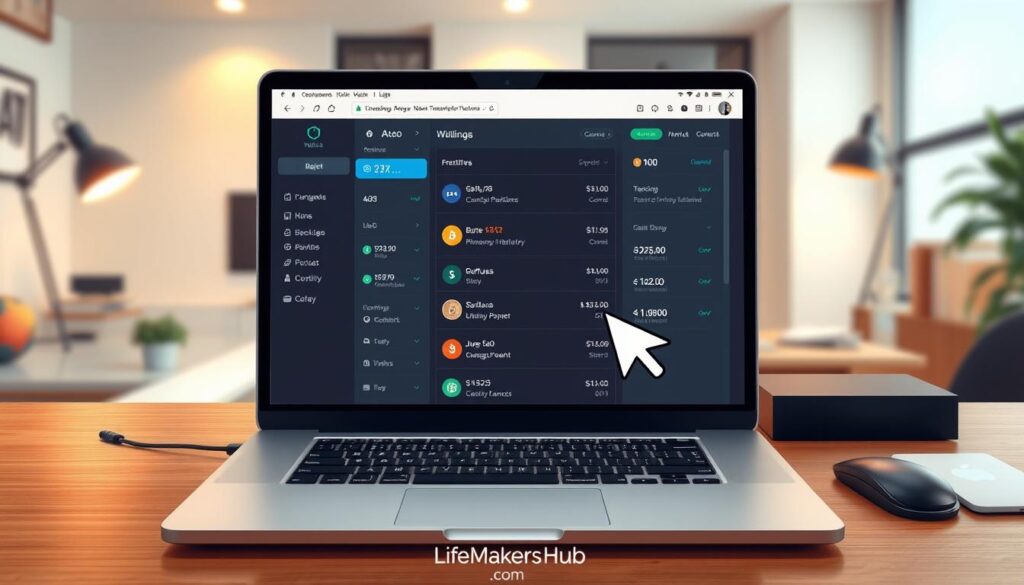Cryptocurrency Investing Made Easy: A Beginner’s Guide
Welcome to the world of digital currencies! Over the past decade, crypto has transformed from a niche concept to a mainstream financial topic. Unlike traditional assets, digital currencies like Bitcoin and Ethereum operate on blockchain technology, ensuring secure and transparent transactions without the need for a central authority.
Initially designed as an alternative payment method, crypto has evolved into a versatile digital asset. Its decentralized nature reduces reliance on banks, offering users more control over their finances. The market operates 24/7, providing flexibility for users worldwide1.
This guide will walk you through the essentials, from setting up your first wallet to understanding market trends. Whether you’re curious about blockchain or ready to explore trading strategies, we’re here to simplify the process and help you make informed decisions.
Key Takeaways
- Digital currencies use blockchain for secure, decentralized transactions.
- The crypto market operates 24/7, unlike traditional financial systems.
- Bitcoin and Ethereum are leading examples of digital assets.
- Decentralization reduces reliance on banks and central authorities.
- This guide provides step-by-step insights for newcomers.
Introduction to Cryptocurrency Investing
The rise of digital currencies has reshaped how we think about money and financial systems. Over the past decade, crypto has moved from a niche concept to a global phenomenon, attracting attention from individual investors and institutions alike. Its decentralized nature and innovative blockchain technology offer a fresh perspective on financial transactions and asset management.
Overview of Digital Currency Trends
Digital currencies like Bitcoin and Ethereum have experienced significant price surges, with Bitcoin increasing roughly tenfold over the last five years2. These trends highlight the growing interest in crypto as a viable alternative to traditional assets. For example, Bitcoin topped $100,000 for the first time in December 2024, showcasing its potential for high returns2.
However, the market is not without its challenges. Price volatility and regulatory shifts continue to influence investor trust. Despite this, 16% of Americans have invested in, traded, or used crypto, according to Pew Research Center data from 20212.
Why More Investors Are Turning to Crypto
One of the key reasons for the growing interest in crypto is its decentralized nature. Unlike traditional financial systems, digital currencies operate without central authorities, giving users more control over their funds. This shift aligns with changing global economic conditions and technological advancements.
Institutional interest is also on the rise. The approval of Bitcoin and Ethereum ETFs by the Securities and Exchange Commission in 2024 has made it easier for traditional investors to enter the market3. Additionally, the energy-intensive nature of Bitcoin mining—consuming more power than all U.S. residential lighting—underscores the innovation behind this technology2.
“The future of finance is being rewritten, and digital currencies are at the forefront,” says a financial analyst. This sentiment captures the transformative potential of crypto in reshaping modern financial systems.
Understanding Cryptocurrency and Blockchain
Blockchain technology has paved the way for a new era of financial innovation. At its core, it’s a decentralized system that ensures secure and transparent transactions. This technology is the backbone of digital currencies, offering a fresh approach to how we handle money.
What is Cryptocurrency?
Cryptocurrency is a digital or virtual form of money that operates without centralized oversight. Unlike traditional currencies issued by governments, it relies on blockchain technology to verify and record transactions. Bitcoin, the first cryptocurrency, was introduced in 2009, followed by Ethereum, which expanded its utility4.
These digital assets are fungible, meaning their value remains consistent when bought, sold, or traded. This feature makes them a reliable medium of exchange in the digital world4.
How Blockchain Technology Secures Transactions
Blockchain acts as a secure, decentralized ledger that records all transactions in an unchangeable format. Each transaction is grouped into a “block” and linked to the previous one, forming a “chain.” This structure ensures transparency and prevents tampering4.
Mining is the process used to validate transactions and add them to the blockchain. It requires specialized hardware and software, making it a resource-intensive but essential part of the system4.
Compared to traditional financial systems, blockchain eliminates the need for intermediaries like banks. This decentralization reduces costs and increases efficiency, making it a game-changer for modern finance.
| Aspect | Blockchain | Traditional Systems |
|---|---|---|
| Control | Decentralized | Centralized |
| Security | High (immutable ledger) | Moderate (prone to fraud) |
| Transaction Speed | Varies (e.g., Bitcoin: 10 mins) | Instant to several days |
| Cost | Lower (no intermediaries) | Higher (bank fees) |
Understanding these fundamentals is crucial for anyone exploring digital assets. Whether you’re curious about Bitcoin or Ethereum, grasping how blockchain works will help you navigate this evolving landscape with confidence.
Cryptocurrency investing guide for beginners

Starting your journey in the digital asset space can feel overwhelming, but breaking it down into simple steps makes it manageable. Whether you’re new to crypto or looking to refine your approach, setting up the right tools is essential. Let’s walk through the basics of creating an account, securing a wallet, and choosing a reliable platform.
Setting Up Your Account and Wallet
The first step is creating a crypto account on a trusted platform. Most exchanges require identity verification to comply with regulations, ensuring a secure transaction environment5. Once your account is set up, you’ll need a wallet to store your digital assets. Wallets come in two main types: hot wallets (connected to the internet) and cold wallets (offline storage).
For beginners, hardware wallets like Ledger or Trezor are highly recommended. They offer enhanced security by keeping your private keys offline, reducing the risk of theft5. Always back up your wallet’s recovery phrase and store it in a safe place. Losing this phrase could mean losing access to your funds permanently.
Choosing a Reliable Exchange or Broker
Selecting the right exchange is crucial for a smooth experience. Look for platforms with strong reputations, transparent fee structures, and robust customer support. Popular options like Coinbase, Binance, and Kraken are trusted by millions of users worldwide6.
Here are key factors to consider when choosing a platform:
- Fees: Compare transaction and withdrawal fees to avoid unnecessary costs.
- Security: Ensure the platform uses encryption and two-factor authentication.
- User Experience: A beginner-friendly interface can make the process less intimidating.
“The right platform can make all the difference in your digital asset journey,” says a financial expert. Take your time to research and choose wisely.
By following these steps, you’ll be well-equipped to start exploring the world of crypto with confidence. Remember, security and patience are your best allies in this evolving landscape.
Evaluating Risks and Rewards in the Crypto Market
Navigating the crypto market requires a clear understanding of its risks and rewards. While the potential for high returns is enticing, the market is known for its volatility and unpredictability. Let’s explore how to manage these challenges and make informed decisions.
Managing Volatility and Market Fluctuations
The crypto market is highly volatile, with prices often experiencing rapid swings. For example, Bitcoin’s price grew from $42,000 in March 2024 to over $100,000 in November 2024, indicating a significant increase of approximately 138% in just eight months7. While such gains are exciting, they come with the risk of sudden drops.
To manage volatility, consider these strategies:
- Diversification: Spread your investments across multiple assets to reduce risk.
- Staking: Earn rewards by participating in proof-of-stake networks, which can provide steady returns.
- Historical Data: Analyze past price trends to identify patterns and make informed trading decisions.
Understanding Fees, Taxes, and Regulatory Impacts
Fees and taxes can significantly impact your overall returns. Every transaction on an exchange incurs fees, which vary depending on the platform. Additionally, the IRS treats crypto as property, meaning you must report gains and losses on your taxes8.
Regulatory changes also play a crucial role. For instance, the U.S. Securities and Exchange Commission warns that investments in crypto asset securities can be exceptionally volatile and speculative8. Staying informed about these regulations helps you navigate the market more effectively.
“Balancing potential rewards with clear-eyed risk assessments is key to success,” says a financial expert. By understanding fees, taxes, and regulations, you can make smarter investment choices.
Practical Steps to Buy and Trade Cryptocurrency

Ready to dive into the world of digital assets? Here’s how to buy and trade with confidence. Whether you’re a beginner or looking to refine your approach, this step-by-step guide will walk you through the process seamlessly.
Step-by-Step Transaction Process
First, connect your wallet to a trusted exchange. Most platforms require identity verification to ensure secure transactions. Once your account is verified, you’re ready to start trading9.
Next, place your buying or selling order. You can choose between market orders (executed immediately at the current price) or limit orders (executed at a specific price). Monitor your order status in real-time to stay informed10.
Here’s a quick checklist to ensure a smooth process:
- Verify your account to avoid delays.
- Choose the right order type based on your goals.
- Check fees before confirming your transaction.
Finally, transfer your funds securely. Double-check wallet addresses to prevent errors. “Accuracy and timeliness are crucial in every step,” says a financial expert. By following these steps, you’ll navigate the crypto landscape with ease.
Enhancing Security and Protecting Your Digital Assets

Protecting your digital assets is crucial in today’s fast-paced crypto environment. With the increasing value of digital currencies, safeguarding your investments has never been more important. Let’s explore actionable steps to enhance your security and keep your assets safe.
Cybersecurity Best Practices for Crypto Users
One of the most effective ways to secure your crypto is by using multi-factor authentication (MFA). This adds an extra layer of protection to your account, making it harder for hackers to gain access11. Additionally, consider using cold wallets for offline storage. These wallets are not connected to the internet, reducing the risk of cyberattacks12.
Here are some critical measures every crypto user should implement:
- Cold Wallets: Store the majority of your funds offline. For example, 95% of Kraken’s crypto funds are kept in cold wallets12.
- Strong Passwords: Use unique, complex passwords for your exchange and wallet accounts11.
- Regular Updates: Keep your software and wallets updated to protect against vulnerabilities11.
Online exchanges are often targeted by hackers. In 2021, Bitmart lost over $200 million in a single hack12. To mitigate such risks, choose platforms with robust security features and regulatory compliance. Always verify the platform’s reputation before making any transactions.
“Proactive measures are your best defense against cyber threats,” says a cybersecurity expert. By staying vigilant and implementing these practices, you can significantly reduce the risk of losing your assets.
Finally, monitor your accounts regularly for any suspicious activity. Early detection can prevent potential losses and ensure your crypto remains secure. Remember, security is not a one-time task but an ongoing process.
Advanced Strategies to Grow Your Crypto Portfolio

Taking your crypto portfolio to the next level requires strategic planning and innovative thinking. Beyond the basics, advanced techniques can help you maximize returns and stay competitive in a dynamic market.
Diversification and Alternative Investment Approaches
One of the most effective ways to grow your crypto holdings is through diversification. Spreading your investments across multiple assets—like Bitcoin, Ethereum, and promising altcoins—can reduce risk and increase potential rewards13.
Consider alternative investment avenues like staking and yield farming. Staking allows you to earn rewards by participating in proof-of-stake networks, while yield farming leverages decentralized finance (DeFi) platforms to generate returns13.
“Diversification isn’t just about spreading risk—it’s about uncovering new opportunities,” says a financial expert. Balancing major cryptocurrencies with emerging projects can create a resilient portfolio.
Staying Ahead with Emerging Crypto Technologies
The crypto landscape is constantly evolving, with new technologies reshaping the market. Staying updated on trends like layer-2 solutions, Web3 protocols, and NFT innovations can give you a competitive edge13.
For example, Ethereum’s Total Value Locked (TVL) has surged, highlighting its dominance in smart contract platforms. Similarly, projects like Solana have seen exponential growth, offering early investors significant returns14.
Leveraging these trends requires research and timing. Monitor emerging projects, analyze their potential, and invest strategically to capitalize on growth opportunities.
“The future of crypto lies in innovation—those who adapt will thrive,” says a blockchain analyst. By staying informed and proactive, you can position yourself for long-term success.
Conclusion
Exploring the world of digital assets opens doors to innovative financial opportunities. Throughout this guide, we’ve covered the essentials—from understanding blockchain technology to navigating the market with confidence. Whether you’re setting up a secure wallet or analyzing trends, informed decision-making is your greatest asset15.
Remember, the crypto landscape is dynamic. Staying updated on emerging technologies and regulatory changes ensures you’re always one step ahead. Diversification and secure transactions are key to managing risks while maximizing potential rewards16.
Take the first step today. Set up your exchange account, explore trusted platforms, and continue learning. Your journey into digital assets is just beginning—embrace it with curiosity and confidence.
FAQ
What is cryptocurrency?
How does blockchain technology work?
How do I start investing in crypto?
What are the risks of investing in crypto?
How do I choose a secure wallet?
What fees are involved in crypto transactions?
How can I protect my crypto investments?
What are some advanced strategies for crypto investing?
Source Links
- A Beginner’s Guide to Day Trading Crypto | Gemini
- Cryptocurrency Basics: Pros, Cons and How It Works – NerdWallet
- How To Start Investing In Cryptocurrency: A Guide For Beginners | Bankrate
- How Does Cryptocurrency Work? A Beginner’s Guide
- 10 Rules of Investing in Crypto
- Beginner’s Guide To Investing In Cryptocurrency
- How to spot crypto investment opportunities: A beginner’s guide
- How To Evaluate and Analyze Cryptocurrency
- How to trade cryptocurrencies
- How to Trade Cryptocurrency: A Practical Guide for Beginners
- A Step-by-Step Guide to Safe and Compliant Investing
- 2025 Guide: What You Need to Know to Invest in Crypto Safely
- How to Build a Crypto Portfolio in 5 Simple Steps
- 7 Foolproof Crypto Investment Strategies for Beginners | CoinLedger
- Crypto Beginner Investing Tips You Must Know
- Cryptocurrency Explained With Pros and Cons for Investment







